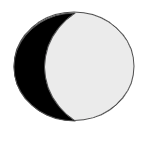All Middle School Earth and Space Science Resources
Example Questions
Example Question #10 : Determine The Next Phase In A Lunar Cycle
Which of the following images best represents a waning gibbous?





The moon generates no light of its own. It can be seen because it reflects the light from the sun. Though it does not always appear so from Earth, half of the moon is always illuminated, and the other half is always in darkness. However, as the moon orbits the Earth, its position in relation to the Earth and the sun changes, and more or less of the illuminated side may be seen from Earth. These different views are called “phases of the moon.”
-
New moon: When the moon is directly between the sun and the Earth, the side of the moon facing the Earth is in darkness; hence, it is not visible in the sky. The light from the sun reflects off the moon back toward the sun; not toward Earth. This phase is called the new moon.
-
Waxing crescent: As the moon continues to move in its orbit around the Earth, a sliver of the illuminated side of the moon becomes visible. This phase is called the waxing crescent. (To wax is to increase.)
-
First quarter: When the moon has completed one quarter of its orbit around the Earth, it makes a right angle with the Earth and the sun. One half of the moon is still illuminated by the sun, and the other half is still in darkness. However, from the Earth, the moon now appears to be a half circle. This phase is called the first quarter.
-
Waxing gibbous: As the moon continues in its orbit, the portion of the illuminated side of the moon visible from the Earth continues to increase. When the moon appears to be more than a half moon but less than a full moon, it is called a gibbous moon. At this point in its orbit, the moon appears to be growing, so this phase is called a waxing gibbous.
-
Full moon: When the moon has completed one half of its orbit around the Earth, it is almost in a straight line with the Earth and the sun. The entire side of the moon that faces Earth is illuminated. This phase is called a full moon.
-
Waning gibbous: The darkened side of the moon begins to reappear to observers after the full moon. This phase is called a waning gibbous. The moon is described as waning when it appears to grow smaller. (To wane is to decrease.)
-
Third quarter: When the moon has completed three‐quarters of its orbit around the Earth, it again makes a right angle with the Earth and the sun. This phase is called the third quarter or last quarter.
-
Waning crescent: As the moon’s orbit continues, the moon appears as a crescent shape once again. Since it appears to grow smaller, this phase is called a waning crescent.
-
New Moon again: The darkened area continues to grow larger until no portion of the illuminated moon can be seen. The moon has returned to the new moon phase.
Certified Tutor
Certified Tutor
All Middle School Earth and Space Science Resources



